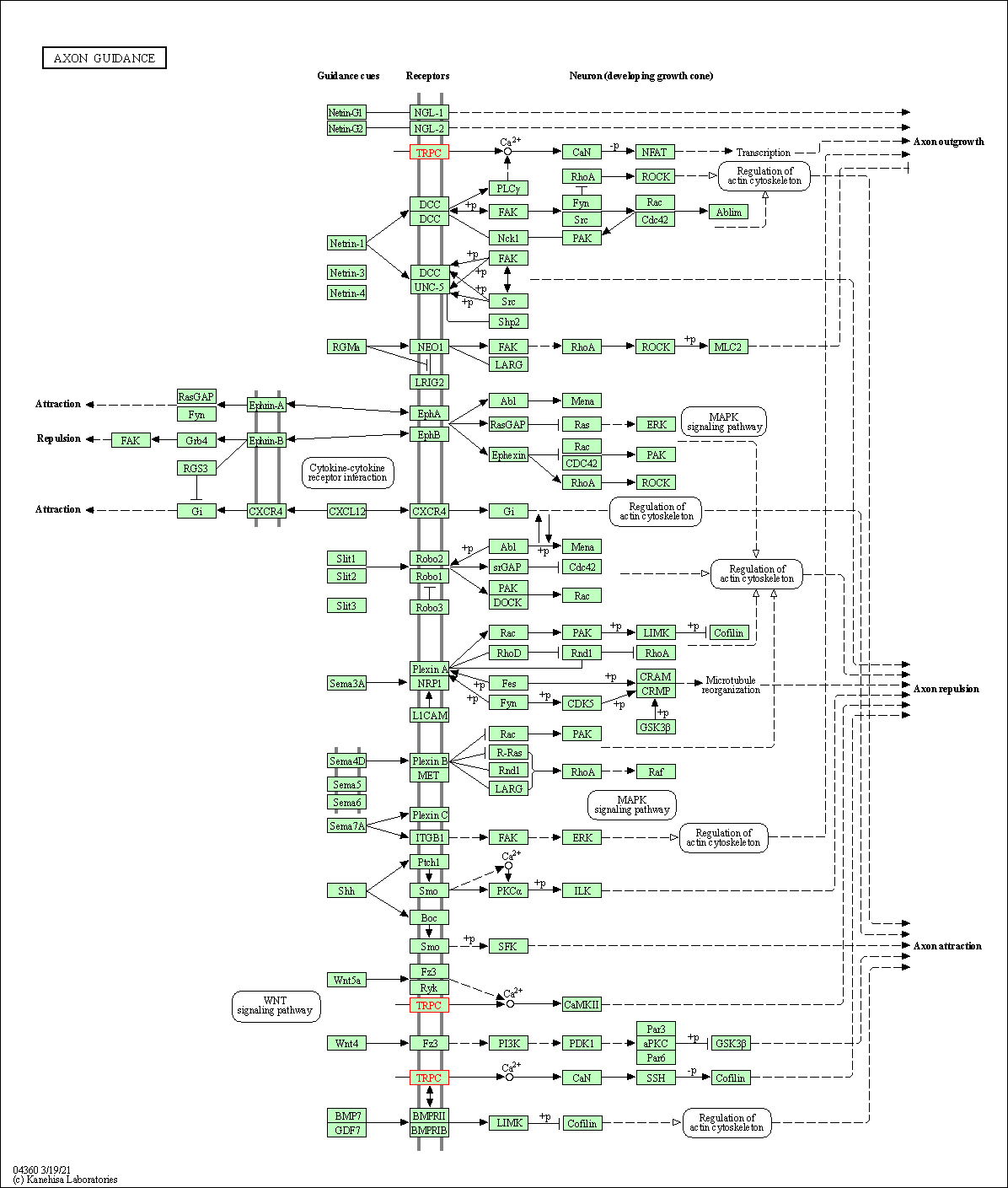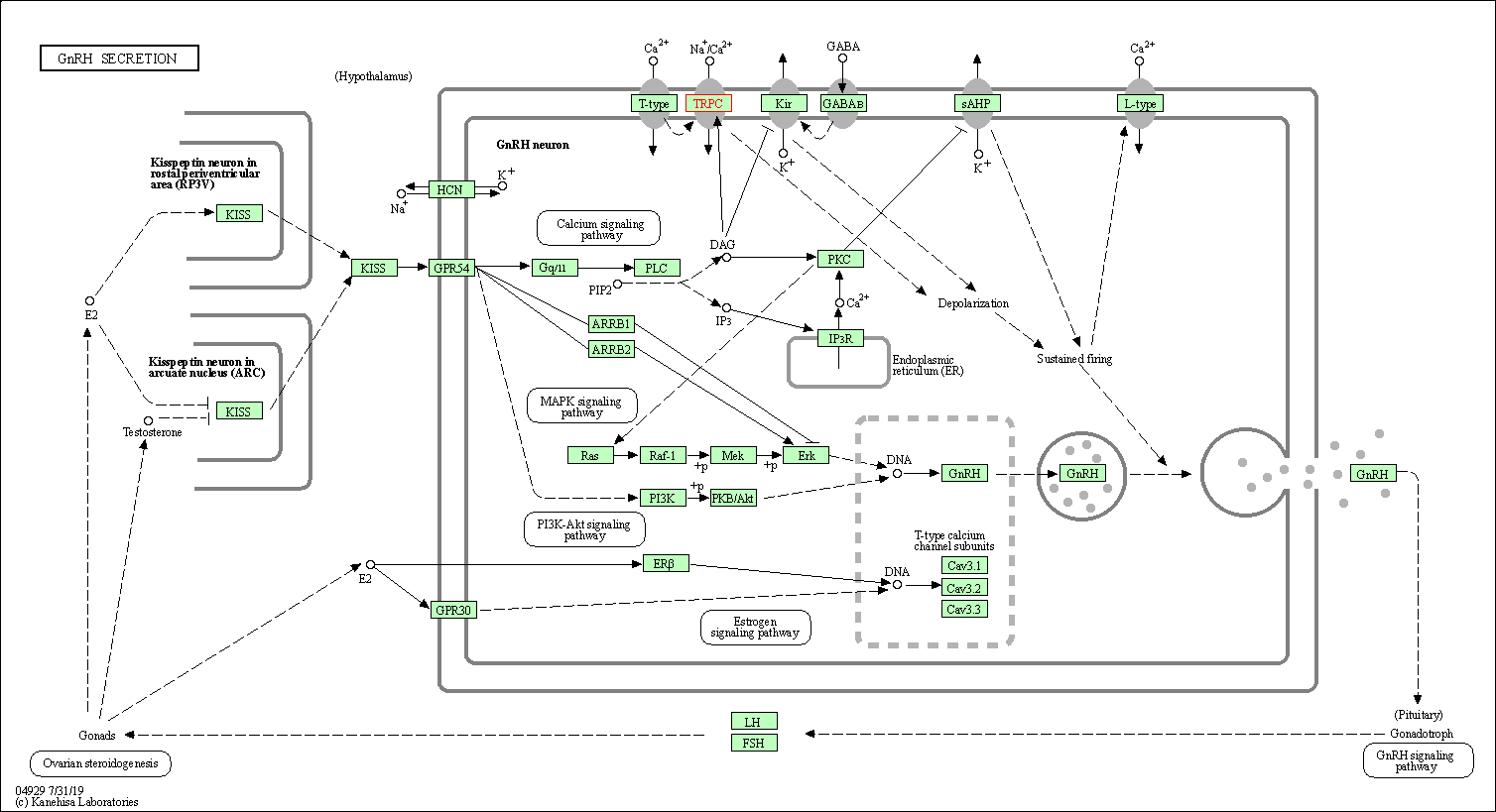Target Information
| Target General Information | Top | |||||
|---|---|---|---|---|---|---|
| Target ID |
T91558
(Former ID: TTDI03591)
|
|||||
| Target Name |
Short transient receptor potential channel 4 (TRPC4)
|
|||||
| Synonyms |
hTrp4; hTrp-4; TrpC4; Trp-related protein 4
Click to Show/Hide
|
|||||
| Gene Name |
TRPC4
|
|||||
| Target Type |
Clinical trial target
|
[1] | ||||
| Disease | [+] 1 Target-related Diseases | + | ||||
| 1 | Depression [ICD-11: 6A70-6A7Z] | |||||
| Function |
Form a receptor-activated non-selective calcium permeant cation channel. Acts as a cell-cell contact-dependent endothelial calcium entry channel. Probably operated by a phosphatidylinositol second messenger system activated by receptor tyrosine kinases or G-protein coupled receptors. Mediates cation entry, with an enhanced permeability to barium over calcium. May also be activated by intracellular calcium store depletion.
Click to Show/Hide
|
|||||
| BioChemical Class |
Transient receptor potential catioin channel
|
|||||
| UniProt ID | ||||||
| Sequence |
MAQFYYKRNVNAPYRDRIPLRIVRAESELSPSEKAYLNAVEKGDYASVKKSLEEAEIYFK
ININCIDPLGRTALLIAIENENLELIELLLSFNVYVGDALLHAIRKEVVGAVELLLNHKK PSGEKQVPPILLDKQFSEFTPDITPIILAAHTNNYEIIKLLVQKGVSVPRPHEVRCNCVE CVSSSDVDSLRHSRSRLNIYKALASPSLIALSSEDPFLTAFQLSWELQELSKVENEFKSE YEELSRQCKQFAKDLLDQTRSSRELEIILNYRDDNSLIEEQSGNDLARLKLAIKYRQKEF VAQPNCQQLLASRWYDEFPGWRRRHWAVKMVTCFIIGLLFPVFSVCYLIAPKSPLGLFIR KPFIKFICHTASYLTFLFLLLLASQHIDRSDLNRQGPPPTIVEWMILPWVLGFIWGEIKQ MWDGGLQDYIHDWWNLMDFVMNSLYLATISLKIVAFVKYSALNPRESWDMWHPTLVAEAL FAIANIFSSLRLISLFTANSHLGPLQISLGRMLLDILKFLFIYCLVLLAFANGLNQLYFY YEETKGLTCKGIRCEKQNNAFSTLFETLQSLFWSIFGLINLYVTNVKAQHEFTEFVGATM FGTYNVISLVVLLNMLIAMMNNSYQLIADHADIEWKFARTKLWMSYFEEGGTLPTPFNVI PSPKSLWYLIKWIWTHLCKKKMRRKPESFGTIGRRAADNLRRHHQYQEVMRNLVKRYVAA MIRDAKTEEGLTEENFKELKQDISSFRFEVLGLLRGSKLSTIQSANASKESSNSADSDEK SDSEGNSKDKKKNFSLFDLTTLIHPRSAAIASERHNISNGSALVVQEPPREKQRKVNFVT DIKNFGLFHRRSKQNAAEQNANQIFSVSEEVARQQAAGPLERNIQLESRGLASRGDLSIP GLSEQCVLVDHRERNTDTLGLQVGKRVCPFKSEKVVVEDTVPIIPKEKHAKEEDSSIDYD LNLPDTVTHEDYVTTRL Click to Show/Hide
|
|||||
| 3D Structure | Click to Show 3D Structure of This Target | AlphaFold | ||||
| Cell-based Target Expression Variations | Top | |||||
|---|---|---|---|---|---|---|
| Cell-based Target Expression Variations | ||||||
| Different Human System Profiles of Target | Top |
|---|---|
|
Human Similarity Proteins
of target is determined by comparing the sequence similarity of all human proteins with the target based on BLAST. The similarity proteins for a target are defined as the proteins with E-value < 0.005 and outside the protein families of the target.
A target that has fewer human similarity proteins outside its family is commonly regarded to possess a greater capacity to avoid undesired interactions and thus increase the possibility of finding successful drugs
(Brief Bioinform, 21: 649-662, 2020).
Human Pathway Affiliation
of target is determined by the life-essential pathways provided on KEGG database. The target-affiliated pathways were defined based on the following two criteria (a) the pathways of the studied target should be life-essential for both healthy individuals and patients, and (b) the studied target should occupy an upstream position in the pathways and therefore had the ability to regulate biological function.
Targets involved in a fewer pathways have greater likelihood to be successfully developed, while those associated with more human pathways increase the chance of undesirable interferences with other human processes
(Pharmacol Rev, 58: 259-279, 2006).
Biological Network Descriptors
of target is determined based on a human protein-protein interactions (PPI) network consisting of 9,309 proteins and 52,713 PPIs, which were with a high confidence score of ≥ 0.95 collected from STRING database.
The network properties of targets based on protein-protein interactions (PPIs) have been widely adopted for the assessment of target’s druggability. Proteins with high node degree tend to have a high impact on network function through multiple interactions, while proteins with high betweenness centrality are regarded to be central for communication in interaction networks and regulate the flow of signaling information
(Front Pharmacol, 9, 1245, 2018;
Curr Opin Struct Biol. 44:134-142, 2017).
Human Similarity Proteins
Human Pathway Affiliation
Biological Network Descriptors
|
|
| Protein Name | Pfam ID | Percentage of Identity (%) | E value |
|---|---|---|---|
| Kinase D-interacting substrate of 220 kDa (KIDINS220) | 28.235 (48/170) | 4.00E-03 |
| KEGG Pathway | Pathway ID | Affiliated Target | Pathway Map |
|---|---|---|---|
| Axon guidance | hsa04360 | Affiliated Target |

|
| Class: Organismal Systems => Development and regeneration | Pathway Hierarchy | ||
| GnRH secretion | hsa04929 | Affiliated Target |

|
| Class: Organismal Systems => Endocrine system | Pathway Hierarchy | ||
| Degree | 2 | Degree centrality | 2.15E-04 | Betweenness centrality | 4.40E-06 |
|---|---|---|---|---|---|
| Closeness centrality | 1.98E-01 | Radiality | 1.34E+01 | Clustering coefficient | 0.00E+00 |
| Neighborhood connectivity | 1.35E+01 | Topological coefficient | 5.00E-01 | Eccentricity | 13 |
| Download | Click to Download the Full PPI Network of This Target | ||||
| Chemical Structure based Activity Landscape of Target | Top |
|---|---|
| Drug Property Profile of Target | Top | |
|---|---|---|
| (1) Molecular Weight (mw) based Drug Clustering | (2) Octanol/Water Partition Coefficient (xlogp) based Drug Clustering | |
|
|
||
| (3) Hydrogen Bond Donor Count (hbonddonor) based Drug Clustering | (4) Hydrogen Bond Acceptor Count (hbondacc) based Drug Clustering | |
|
|
||
| (5) Rotatable Bond Count (rotbonds) based Drug Clustering | (6) Topological Polar Surface Area (polararea) based Drug Clustering | |
|
|
||
| "RO5" indicates the cutoff set by lipinski's rule of five; "D123AB" colored in GREEN denotes the no violation of any cutoff in lipinski's rule of five; "D123AB" colored in PURPLE refers to the violation of only one cutoff in lipinski's rule of five; "D123AB" colored in BLACK represents the violation of more than one cutoffs in lipinski's rule of five | ||
| References | Top | |||||
|---|---|---|---|---|---|---|
| REF 1 | Antibodies and venom peptides: new modalities for ion channels. Nat Rev Drug Discov. 2019 May;18(5):339-357. | |||||
| REF 2 | ClinicalTrials.gov (NCT04423757) A Home-based Study Using Mobile Technology to Test Whether BI 1358894 is Effective in People With Depression. U.S. National Institutes of Health. | |||||
| REF 3 | (-)-Englerin is a potent and selective activator of TRPC4 and TRPC5 calcium channels. Angew Chem Int Ed Engl. 2015 Mar 16;54(12):3787-91. | |||||
| REF 4 | URL: http://www.guidetopharmacology.org Nucleic Acids Res. 2015 Oct 12. pii: gkv1037. The IUPHAR/BPS Guide to PHARMACOLOGY in 2016: towards curated quantitative interactions between 1300 protein targets and 6000 ligands. (Target id: 489). | |||||
| REF 5 | Identification of ML204, a novel potent antagonist that selectively modulates native TRPC4/C5 ion channels. J Biol Chem. 2011 Sep 23;286(38):33436-46. | |||||
If You Find Any Error in Data or Bug in Web Service, Please Kindly Report It to Dr. Zhou and Dr. Zhang.

